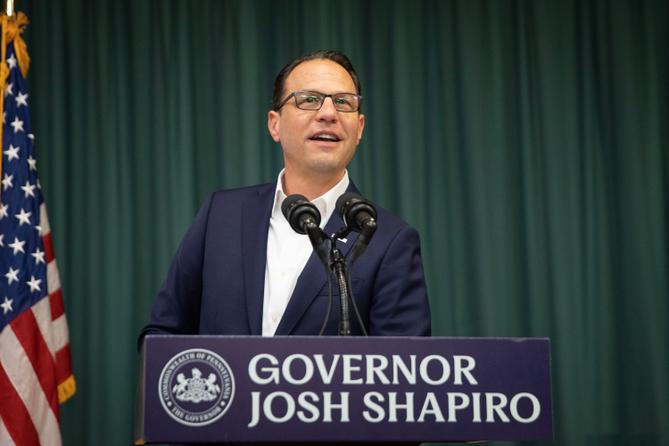This article is made possible through Spotlight PA’s collaboration with Votebeat, a nonpartisan news organization covering local election administration and voting. This article is available for reprint under the terms of Votebeat’s republishing policy.
Republicans at the state and national level are still crying foul over Pennsylvania Gov. Josh Shapiro’s announcement last month that the state had adopted automatic voter registration at motor vehicle offices.
Conservatives are questioning not only the security and motives of the program, but also Shapiro’s authority to unilaterally make such a change without the legislature.
Despite claims of overreach and one threat to sue the governor, no one has yet actually challenged the move in court. A law from 1995 offers clues as to where the authority lies.
Shapiro announced on Sept. 19 that he was directing the Pennsylvania Department of Transportation and the Department of State to change the system by which citizens register to vote while receiving a license or identification card. Whereas employees previously would offer motorists a chance to register to vote, now they automatically lead motorists through the process to register unless motorists opt out. The same documents that confirm a motorist’s identity, citizenship, and address are used in the voter registration submission.
Shapiro, a Democrat, announced the switch on National Voter Registration Day, calling it “a commonsense step to ensure election security and save Pennsylvanians time and tax dollars.” Election officials said that such a system will help keep voter rolls up-to-date when voters update their driver’s license after moving to a new address.
The change was effective immediately, and caught county and legislative leaders by surprise. The Shapiro administration did not answer questions as to why it had not informed others ahead of the announcement.
On the day the program was announced, state House Minority Leader Bryan Cutler (R., Lancaster) said Shapiro’s announcement “disenfranchises the General Assembly from exercising its constitutional prerogative to make laws.” A joint statement from members of state Senate Republican leadership said Shapiro’s announcement was a “unilateral decision made by the Executive Branch and without input by the General Assembly.”
While those statements have emphasized questions about Shaprio’s authority, other Republican leaders have suggested the move was partisan and questioned safeguards around the program.
Former President Donald Trump said on social media last week that the move would be a “disaster” for electing Republicans, called it unconstitutional, and said the Republican National Committee and Pennsylvania Republican Party “must … not let this happen.”
The RNC and Pennsylvania Republican Party appear to have heard the call. They sent a joint letter to the Department of State and PennDOT the next day questioning the legality of the program and asking how ineligible voters would be kept off the rolls.
The winding road to Motor Voter
The National Voter Registration Act of 1993, commonly known as the “Motor Voter Act,” required state motor vehicle departments to provide eligible voters with the option to register to vote when interacting with the agency.
But before Pennsylvania could direct PennDOT to administer the program, it had to enact legislation to do so.
Disputes in the legislature caused Pennsylvania to miss the deadline for enacting legislation, and the state, along with others, was sued into compliance by the Department of Justice.
The Pennsylvania Voter Registration Act, which codified the system into law, was eventually passed in 1995, according to a newspaper report from the Pittsburgh Post-Gazette at the time.
The act suggests the legislature gave the secretary of the commonwealth — who serves at the pleasure of the governor — the power to make decisions on implementing voter registration at PennDOT without legislative approval.
“The secretary has the primary responsibility for implementing and enforcing the driver's license voter registration system created under this section,” the act reads. “The secretary, in consultation with the Secretary of Transportation, may promulgate regulations for implementing this section.”
Another section states that the “format” of the voter registration application “shall be determined and prescribed by the secretary and the Secretary of Transportation.”
While that original act has since been repealed and incorporated into other sections of the law, that language remains in a provision of the state’s Election Code, cited in the Republican letters.
Manuel Bonder, a spokesperson for the governor, pointed to this section as justification for Shapiro’s move. He also highlighted a portion of the federal Motor Voter Act itself, which says that a state’s driver’s license application “shall serve as an application for voter registration” for federal elections “unless the applicant fails to sign the voter registration application.”
Impact of automatic voter registration
Shapiro’s move made Pennsylvania the 25th state to enact some form of automatic voter registration, according to the Voting Rights Lab — but the only one to do so via gubernatorial announcement, according to the National Conference of State Legislatures.
Automatic voter registration has been primarily enacted by Democratic officials since Oregon became the first in 2016. Some Republican-controlled states — such as Alaska and West Virginia in 2016 — have adopted the program, and Republican governors in blue states such as Illinois, Maryland, and Massachusetts have supported it.
Georgia enacted the program in 2016, under an order from the Republican secretary of state.
When Shapiro announced Pennsylvania’s change to an opt-out voter registration system, it was with the hope it would increase voter registration and, ultimately, participation. A study in Georgia showed that switching did increase registration rates. However, a 2019 analysis from FiveThirtyEight shows that these new voters are slightly less likely to actually vote than voters who registered in other ways.
“It’s empirically and just logically the case that if you're doing anything to reach out to people who haven't registered to vote already, you’re talking about a population who already isn’t as interested in registering to vote,” said Charles Stewart, a professor of political science at MIT who studies elections.
Stewart said that generally, those who are registered through automatic voter registration are “low propensity” voters who are less likely to cast ballots.
“Of those people who get on [the voter rolls] automatically, you're going to find a minor fraction of them actually end up voting,” he said. “So the increase in the turnout rate will be much much lower than the increase in the registration rate.”
Automatic registration may also benefit Republicans more than Democrats, he said, as it is more likely to register rural voters who have more need for a driver’s license than urban voters who have better access to public transportation. A secondary effect of automatic registration is also that it gives voting advocates and campaigns a greater number of voters to target during get-out-the-vote drives.
“They become much more fair game for mobilization, and that's where I think in Pennsylvania in the long run, or even in the 2024 election, there may be more of a [turnout] bounce because of the pivotal nature of Pennsylvania in the electoral college,” he said.
What’s next for automatic voter registration in Pennsylvania
Some Republican members of the state House and Senate have begun floating legal theories under which they might challenge Shapiro’s decision.
State Sen. Cris Dush (R, Jefferson), who chairs the chamber’s State Government Committee, called the move tyranny in a Facebook video last week, and said it amounted to “official oppression” because changing the system to opt out made registering compulsory and took away a citizen’s right to decline registration.
The new PennDOT system does not make registration mandatory. Slides provided to Votebeat and Spotlight PA show the on-screen registration process, which requires motorists to hit the “enter” key to continue or the number 9 key to opt out, giving them agency.
Dush said the move could bring “potential” lawsuits, but did not threaten to file one himself.
State Senate leadership has not adopted Dush’s legal theory. A spokesperson for the Republican caucus said only that “discussions are ongoing regarding the changes that have been made.”
The Freedom Caucus, a coalition of far-right legislators in the state House, said it would sue over the plan, though the press release did not specify the legal grounds on which the suit would rest.
State Rep. Dawn Keefer (R., York), who chairs the caucus, said last Wednesday the caucus was still speaking with its attorneys and “exploring a few different angles.”
Similar to the state Senate, state House Republican Leadership has not gone as far as some of its members.
“We are continuing to review the specifics of the plan,” Jason Gottesman, a spokesperson for state House Republicans, said last week in a statement to Votebeat and Spotlight PA. “Regardless of legal authority, it remains inappropriate for the administration to use unilateral action to disenfranchise the General Assembly of its constitutional lawmaking duties.”
As of Tuesday, no legal challenge against the change has been filed.
BEFORE YOU GO… If you learned something from this article, pay it forward and contribute to Spotlight PA at spotlightpa.org/donate. Spotlight PA is funded by foundations and readers like you who are committed to accountability journalism that gets results.

